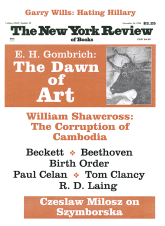In response to:
Afghanistan's Other War from the December 18, 1986 issue
To the Editors:
Seemingly out of nowhere, a youthful fundamentalist fighting force called the Taliban emerged in Afghanistan two years ago, rapidly taking control of large segments of the country and, last month, the long-contested capital of Kabul, almost without a fight. Its leaders murdered Najibullah, Afghanistan’s president under the Soviets who had been granted UN protection in Kabul after being deposed. They strung up his body and that of his brother and chief of security, leaving them to be gawked at in a city square. They have demanded that the women of Kabul, many of whom are emancipated and modern in their ways, cover themselves from head to toe before appearing in public, and they have denied women the right to work or attend school. Other Afghan mujahedin commanders are now regrouping in an attempt to stop the Taliban advance to the north. Who are the Taliban and from where did they come?
Readers of The New York Review of Books may remember an article I wrote about Afghanistan in these pages ten years ago, in 1986 [“Afghanistan’s Other War,” NYR, December 18, 1986]. I had gone to the Afghan border to write about the child victims of the Soviet-Afghan struggle and, in particular, to investigate reports that the Soviets were abducting Afghan orphans to the Soviet Union to train them in Marxist-Leninist ideology for a role in a future Communist Afghanistan. I interviewed scores of children and youths in refugee orphanages and Pakistani-run madrasas in the tribal territories and other parts of the Northwest Frontier Province of Pakistan. There I discovered something I had not expected.
True, the Soviets were taking small groups of children to the Soviet Union for re-education. But far more appalling was the “education” being given to the refugee children in Pakistan. Hundreds of thousands of youths, who knew nothing of life but the bombings that destroyed their homes and drove them to seek refuge over the border, were being raised to hate and to fight, “in the spirit of Jihad,” a “holy war” that would restore Afghanistan to its people. “New kinds of Afghans are being born in the struggle,” I reported. “Caught in the midst of a grownups’ war, the young Afghans are under intense political pressure from one side or another, almost from birth. These children are being deprived of what seem to me the essential rights they should have. Among these are the right to an education that prepares them to think independently and the right to decide for themselves what is best for their country.”
The children that I interviewed and wrote about in 1986 are now young adults. Many are now with the Taliban.
Jeri Laber
Senior Adviser
Human Rights Watch
New York City
This Issue
November 14, 1996



